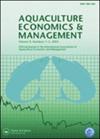Shrimp export competitiveness and its determinants: a novel dynamic ARDL simulations approach
IF 3.7
2区 经济学
Q1 AGRICULTURAL ECONOMICS & POLICY
引用次数: 5
Abstract
Abstract This study aims to explore the shrimp export competitiveness of Bangladesh, China, India, Indonesia, Thailand, and Vietnam time spanning from 1990 to 2019. However, emphasizing Bangladesh as a case country, this research looks into the factors influencing shrimp export competitiveness taking into account macroeconomic and policy variables. To do so, we used the recently developed Revealed Symmetric Comparative Advantage (RSCA) index to quantify export competitiveness, while a novel dynamic autoregressive distributed lag (ARDL) simulation approach to determine the factors driving shrimp export competitiveness. The findings show that all of the aforementioned countries seem to have some degree of shrimp export competitiveness during the study period, whereas Chain has entirely lost its export competitiveness after 2004. However, Bangladesh's shrimp export competitiveness has dipped marginally in recent years, despite continuous growth in competitor countries such as India, Indonesia, and Vietnam. Further, economic globalization, institutional quality, trade openness, number of trade agreements, and trade freedom all have a favorable impact on Bangladesh’s shrimp export competitiveness in the long-run, whereas the international or exporting price of shrimp has a detrimental influence in short-and long-run. Finally, these findings may have implications for a future shrimp export from Bangladesh and some policy recommendation are presented.虾出口竞争力及其决定因素:一种新的动态ARDL模拟方法
摘要本研究旨在探讨1990年至2019年孟加拉国、中国、印度、印度尼西亚、泰国和越南的虾出口竞争力。然而,本研究强调孟加拉国是一个案例国家,考虑到宏观经济和政策变量,探讨了影响虾出口竞争力的因素。为此,我们使用最近开发的揭示对称比较优势(RSCA)指数来量化出口竞争力,同时使用一种新的动态自回归分布滞后(ARDL)模拟方法来确定驱动虾出口竞争力的因素。研究结果表明,在研究期间,上述所有国家似乎都具有一定程度的虾出口竞争力,而Chain在2004年后完全失去了出口竞争力。然而,尽管印度、印度尼西亚和越南等竞争国家的虾出口持续增长,但孟加拉国的虾出口竞争力近年来略有下降。此外,从长远来看,经济全球化、制度质量、贸易开放、贸易协议数量和贸易自由都对孟加拉国的虾出口竞争力产生了有利影响,而虾的国际或出口价格在短期和长期内都会产生不利影响。最后,这些发现可能对孟加拉国未来的虾出口产生影响,并提出了一些政策建议。
本文章由计算机程序翻译,如有差异,请以英文原文为准。
求助全文
约1分钟内获得全文
求助全文
来源期刊

Aquaculture Economics & Management
FISHERIES-
CiteScore
7.30
自引率
17.90%
发文量
21
期刊介绍:
Aquaculture Economics and Management is a peer-reviewed, international journal which aims to encourage the application of economic analysis to the management, modeling, and planning of aquaculture in public and private sectors. The journal publishes original, high quality papers related to all aspects of aquaculture economics and management including aquaculture production and farm management, innovation and technology adoption, processing and distribution, marketing, consumer behavior and pricing, international trade, policy analysis, and the role of aquaculture in food security, livelihoods, and environmental management. Papers are peer reviewed and evaluated for their scientific merits and contributions.
 求助内容:
求助内容: 应助结果提醒方式:
应助结果提醒方式:


